Picking a client certificate
Initially, when you open Windows Admin Center on Windows 10, make sure to choose the Windows Admin Center Client certificate (else, you’ll get an HTTP 403 error saying “can’t get to this page”).
In Microsoft Edge, when you are prompted with this dialog:
- Click More choices
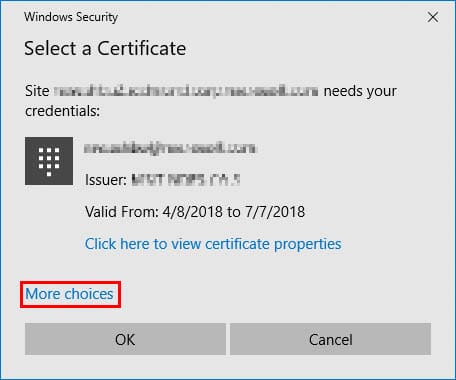
- Select the certificate labeled Windows Admin Center Client and click OK
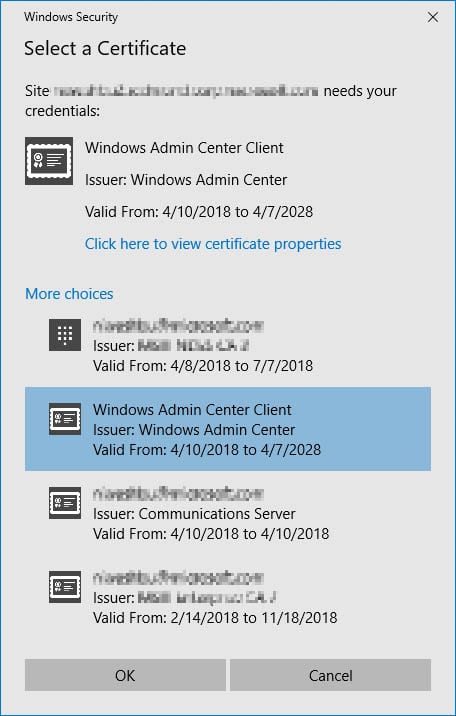
- Make sure Always Allow Access is selected and click Allow
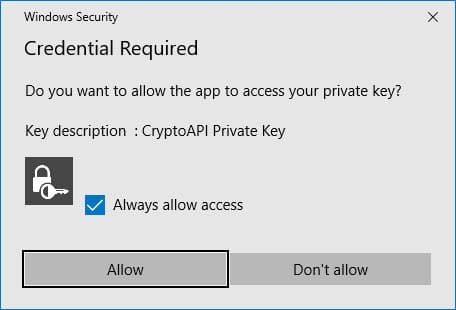
Connecting to managed nodes and clusters
After you finish the installation of Windows Admin Center, you can add servers or clusters to manage from the main overview page.
Add a single server or a cluster as a managed node
- Click + Add under All Connections
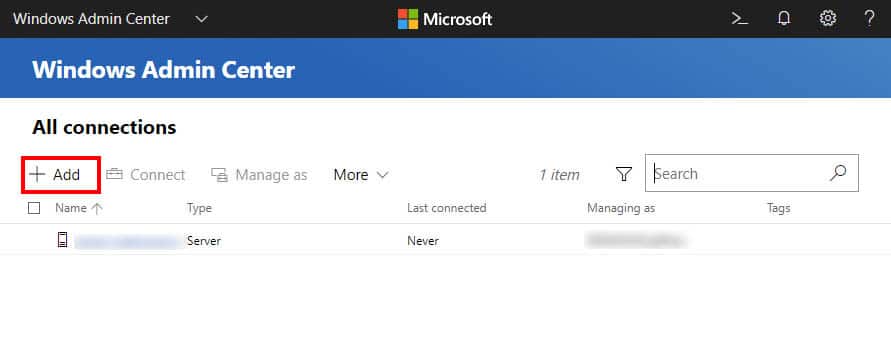
- Choose to add a Server, Failover Cluster or Hyper-Converged Cluster connection:
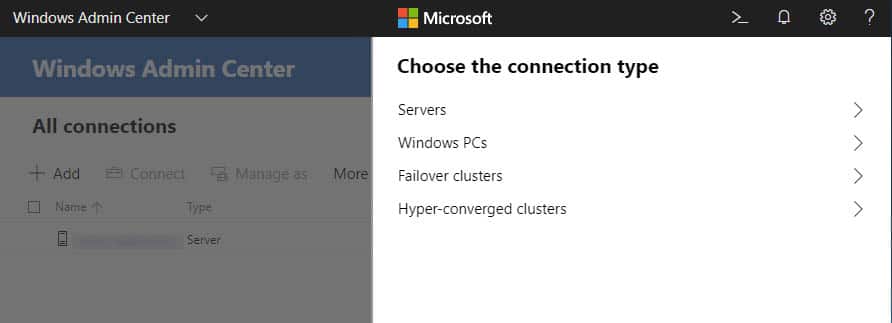
- Type the name of the server or cluster to manage and click Submit. The server or cluster will be added to your connection list on the overview page.
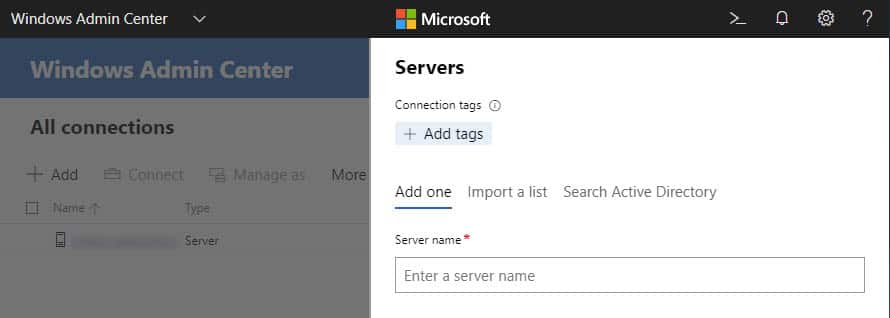
Or bulk import multiple servers
- On the Add Server Connection page, choose the Import Servers tab
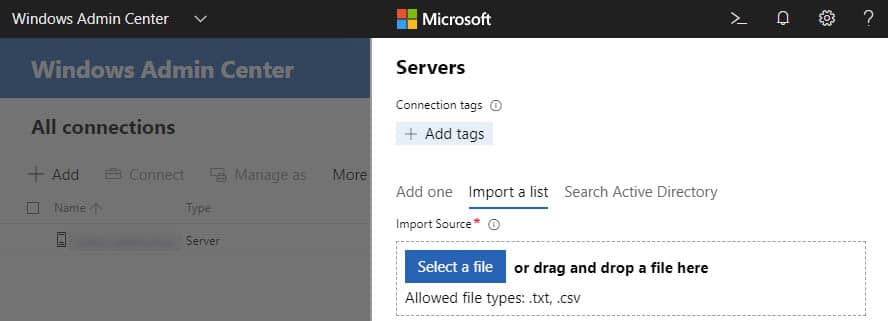
- Click Browse and select a text file that contains a comma, or new line separated, list of FQDNs for the servers you want to add.
Or add servers by searching Active Directory
- On the Add Server Connection page, choose the Search Active Directory tab.
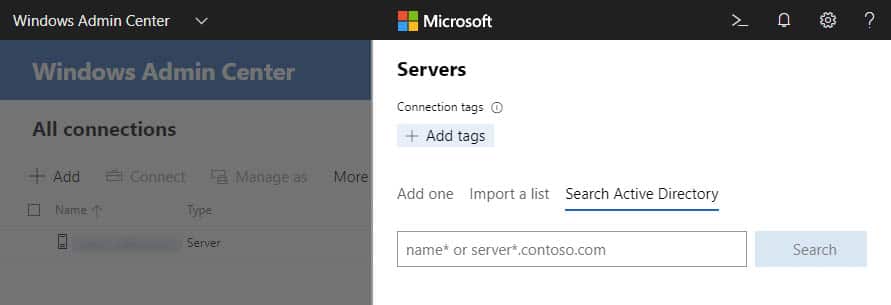
- Enter your search criteria and click Search. Wildcards (*) are supported.
- After the search completes – select one or more of the results, optionally add tags, and click Add.
Authenticate with the managed node
Windows Admin Center supports several mechanisms for authenticating with a managed node. Single sign-on is the default.
Single Sign-on
You can use your current Windows credentials to authenticate with the managed node. This is the default, and Windows Admin Center attempts the sign-on when you add a server.
Single sign-on when deployed as a Service on Windows Server
If you have installed Windows Admin Center on Windows Server, additional configuration is required for single sign-on. Configure your environment for delegation
Or Use Manage As to Specify credentials
Under All Connections, select a server from the list and choose Manage As to specify the credentials that you will use to authenticate to the managed node:

If Windows Admin Center is running in service mode on Windows Server, but you do not have Kerberos delegation configured, you must re-enter your Windows credentials:
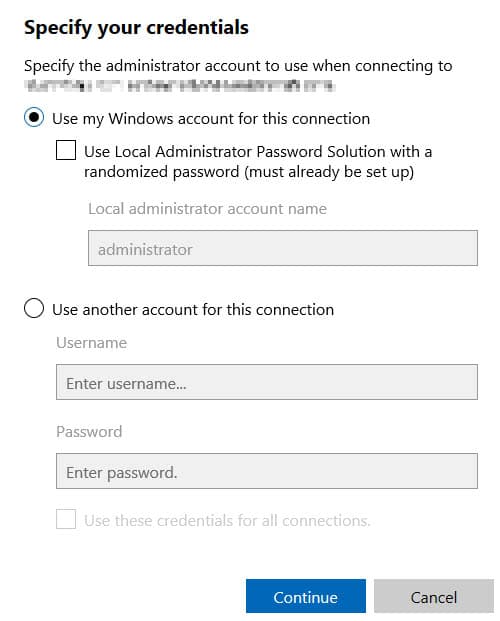
You may apply the credentials to all connections, which will cache them for that specific browser session. If you reload your browser, you must re-enter your Manage As credentials.
Local Administrator Password Solution (LAPS)
If your environment uses LAPS, and you have Windows Admin Center installed on your Windows 10 PC, you can use LAPS credentials to authenticate with the managed node. If you use this scenario, please provide feedback.
Using tags to organize your connections
You can use tags to identify and filter related servers in your connection list. This allows you to see a subset of your servers in the connection list. This is especially useful if you have many connections.
Edit tags
- Select a server or multiple servers in the All Connections list
- Under All Connections, click Edit Tags
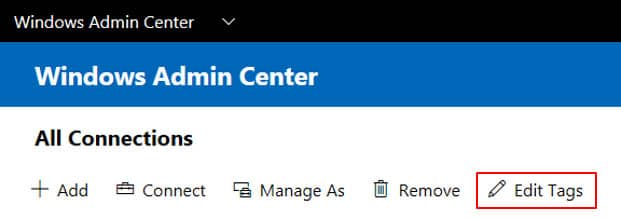
The Edit Connection Tags pane allows you to modify, add, or remove tags from your selected connection(s):
- To add a new tag to your selected connection(s), select Add tag and enter the tag name you would like to use.
- To tag the selected connections with an existing tag name, check the box next to the tag name you wish to apply.
- To remove a tag from all selected connections, uncheck the box next to the tag you wish to remove.
- If a tag is applied to a subset of the selected connections, the checkbox is shown in an intermediate state. You can click the box to check it and apply the tag to all selected connections or click again to uncheck it and remove the tag from all selected connections.
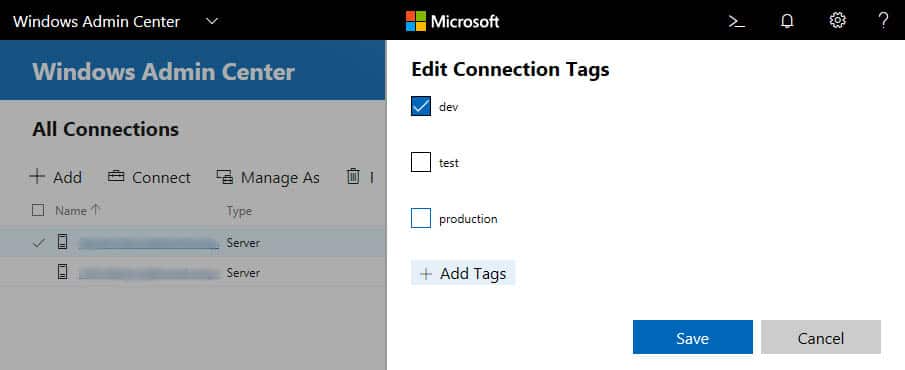
Filter connections by tag
Once tags have been added to one or more server connections, you can view the tags on the connection list, and filter the connection list by tags.
- To filter by a tag, select the filter icon next to the search box.

- You can select “or”, “and”, or “not” to modify the filter behavior of the selected tags.
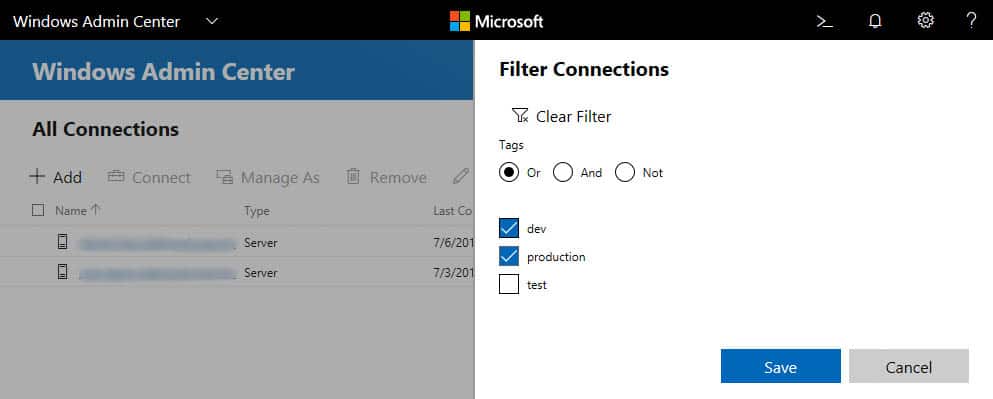
Use PowerShell to import or export your connections (with tags)
Applies To: Windows Admin Center Preview
Windows Admin Center Preview includes a PowerShell module to import or export your connection list.
PowerShell
# Load the module
Import-Module "$env:ProgramFiles\windows admin center\PowerShell\Modules\ConnectionTools"
# Available cmdlets: Export-Connection, Import-Connection
# Export connections (including tags) to .csv files
Export-Connection "https://wac.contoso.com" -fileName "WAC-connections.csv"
# Import connections (including tags) from .csv files
Import-Connection "https://wac.contoso.com" -fileName "WAC-connections.csv"CSV file format for importing connections
The format of the CSV file starts with the four headings "name","type","tags","groupId", followed by each connection on a new line.
name is the FQDN of the connection
type is the connection type. For the default connections included with Windows Admin Center, you will use one of the following:
| Connection type | Connection string |
|---|---|
| Windows Server | msft.sme.connection-type.server |
| Windows 10 PC | msft.sme.connection-type.windows-client |
| Failover Cluster | msft.sme.connection-type.cluster |
| Hyper-Converged Cluster | msft.sme.connection-type.hyper-converged-cluster |
tags are pipe-separated.
groupId is used for shared connections. Use the value global in this column to make this a shared connection.
Example CSV file for importing connections
"name","type","tags","groupId"
"myServer.contoso.com","msft.sme.connection-type.server","hyperv" "myDesktop.contoso.com","msft.sme.connection-type.windows-client","hyperv" "teamcluster.contoso.com","msft.sme.connectiontype.cluster","legacyCluster|WS2016","global" "myHCIcluster.contoso.com,"msft.sme.connection-type.hyper-converged-cluster","myHCIcluster|hyperv|JIT|WS2019" "teamclusterNode.contoso.com","msft.sme.connection-type.server","legacyCluster|WS2016","global" "myHCIclusterNode.contoso.com","msft.sme.connection-type.server","myHCIcluster|hyperv|JIT|WS2019" Import RDCman connections
Use the script below to export saved connections in RDCman to a file. You can then import the file into Windows Admin Center, maintaining your RDCMan grouping hierarchy using tags. Try it out!
- Copy and paste the code below into your PowerShell session:
PowerShell
#Helper function for RdgToWacCsv
function AddServers {
param (
[Parameter(Mandatory = $true)]
[Xml.XmlLinkedNode]
$node,
[Parameter()]
[String[]]
$tags,
[Parameter(Mandatory = $true)]
[String]
$csvPath
)
if ($node.LocalName -eq 'server') {
$serverName = $node.properties.name
$tagString = $tags -join "|"
Add-Content -Path $csvPath -Value ('"'+ $serverName + '","msft.sme.connection-type.server","'+ $tagString +'"')
}
elseif ($node.LocalName -eq 'group' -or $node.LocalName -eq 'file') {
$groupName = $node.properties.name
$tags+=$groupName
$currNode = $node.properties.NextSibling
while ($currNode) {
AddServers -node $currNode -tags $tags -csvPath $csvPath
$currNode = $currNode.NextSibling
}
}
else {
# Node type isn't relevant to tagging or adding connections in WAC
}
return
}
<#
.SYNOPSIS
Convert an .rdg file from Remote Desktop Connection Manager into a .csv that can be imported into Windows Admin Center, maintaining groups via server tags. This will not modify the existing .rdg file and will create a new .csv file
.DESCRIPTION
This converts an .rdg file into a .csv that can be imported into Windows Admin Center.
.PARAMETER RDGfilepath
The path of the .rdg file to be converted. This file will not be modified, only read.
.PARAMETER CSVdirectory
Optional. The directory you wish to export the new .csv file. If not provided, the new file is created in the same directory as the .rdg file.
.EXAMPLE
C:\PS> RdgToWacCsv -RDGfilepath "rdcmangroup.rdg"
#>
function RdgToWacCsv {
param(
[Parameter(Mandatory = $true)]
[String]
$RDGfilepath,
[Parameter(Mandatory = $false)]
[String]
$CSVdirectory
)
[xml]$RDGfile = Get-Content -Path $RDGfilepath
$node = $RDGfile.RDCMan.file
if (!$CSVdirectory){
$csvPath = [System.IO.Path]::GetDirectoryName($RDGfilepath) + [System.IO.Path]::GetFileNameWithoutExtension($RDGfilepath) + "_WAC.csv"
} else {
$csvPath = $CSVdirectory + [System.IO.Path]::GetFileNameWithoutExtension($RDGfilepath) + "_WAC.csv"
}
New-item -Path $csvPath
Add-Content -Path $csvPath -Value '"name","type","tags"'
AddServers -node $node -csvPath $csvPath
Write-Host "Converted $RDGfilepath `nOutput: $csvPath"
}- To create a .CSV file, run the following command:
PowerShell
RdgToWacCsv -RDGfilepath "path\to\myRDCManfile.rdg"- Import the resulting .CSV file in to Windows Admin Center, and all your RDCMan grouping hierarchy will be represented by tags in the connection list. For details, see Use PowerShell to import or export your connections (with tags).
View PowerShell scripts used in Windows Admin Center
Once you’ve connected to a server, cluster, or PC, you can look at the PowerShell scripts that power the UI actions available in Windows Admin Center. From within a tool, click the PowerShell icon in the top application bar. Select a command of interest from the dropdown to navigate to the corresponding PowerShell script.
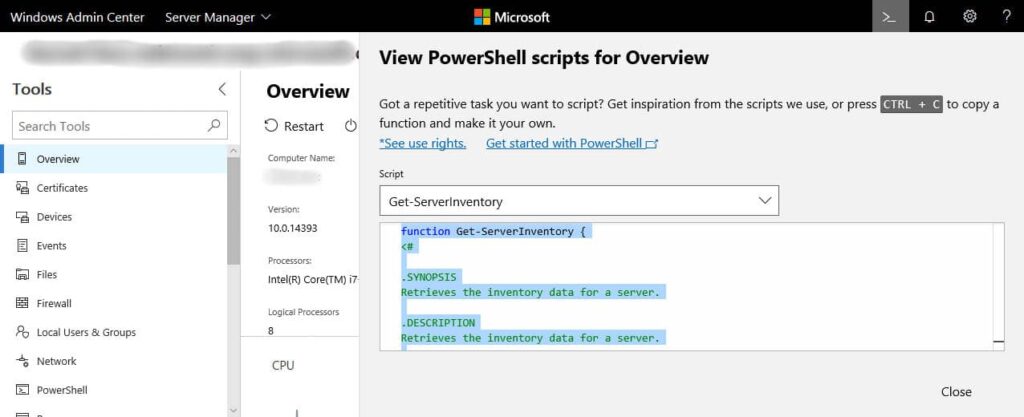
Call Our IT Specialists For Support Now at 972-528-6546


